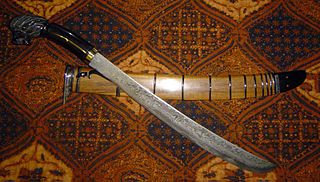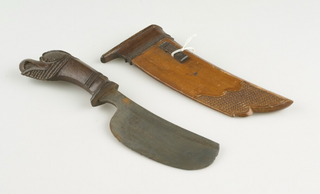
The kris or keris is a Javanese asymmetrical dagger with a distinctive blade-patterning achieved through alternating laminations of iron and nickelous iron (pamor). The kris is famous for its distinctive wavy blade, although many have straight blades as well, and is one of the weapons commonly used in the pencak silat martial art native to Indonesia. Kris have been produced in many regions of Indonesia for centuries, but nowhere—although the island of Bali comes close—is the kris so embedded in a mutually-connected whole of ritual prescriptions and acts, ceremonies, mythical backgrounds and epic poetry as in Central Java. Within Indonesia the kris is commonly associated with Javanese culture, although other ethnicities in it and surrounding regions are familiar with the weapon as part of their cultures, such as the Balinese, Sundanese, Malay, Madurese, Banjar, Buginese, and Makassar people. The kris itself is considered as a cultural symbol of Indonesia and also neighbouring countries like Brunei, Malaysia, Philippines, Singapore, and Thailand.

A golok is a cutting tool, similar to a machete, that comes in many variations and is found throughout the Malay Archipelago. It is used as an agricultural tool as well as a weapon. The word golok is used in Indonesia and Malaysia. Both in Malaysia and in Indonesia, the term is usually interchangeable with the longer and broader parang. In the Sundanese region of West Java it is known as bedog. In the Philippines, the term gulok, refers to different dagger weapons including the kris.

A kalis is a type of Philippine sword. The kalis has a double-edged blade, which is commonly straight from the tip but wavy near the handle. Kalis exists in several variants, either with a fully straight or fully wavy blade. It is similar to the Javanese keris, but differs in that the kalis is a sword, not a dagger. It is much larger than the keris and has a straight or slightly curved hilt, making it a primarily heavy slashing weapon.

The klewang or kelewang is a category of traditional single-edged sword that can be found throughout the Malay Archipelago. Usually it is shorter than a pedang (sword) but longer than a golok (machete). There are straight bladed types, but most are curved.

Listed here are the weapons of pencak silat. The most common are the machete, staff, kris, sickle, spear, and kerambit. Because Southeast Asian society was traditionally based around agriculture, many of these weapons were originally farming tools.

The pinas, sometimes called "pinis" as well, is a type of schooner of the east coast of the Malay peninsula, built in the Terengganu area. This kind of vessel was built of Chengal wood by the Malays since the 19th century and roamed the South China Sea and adjacent oceans as one of the two types of traditional sailing vessels the late Malay maritime culture has developed: The bedar and the pinas.

Niabor is a curved sword from Borneo, a characteristic weapon of the Sea-Dayaks.

Jimpul is a traditional weapon of the Sea Dayak and Kenyah people from Borneo. It is often thought that the Parang Jimpul may be considered as a hybrid between the Mandau and Langgai Tinggang. The Parang Jimpul is an intermediary form between the Mandau and the Langgai Tinggang dating from c. 1870-c. 1885.

The Pandat is the war sword of the Dayak people of northwest Borneo and is never used as a tool. On October 18, 2016, this weapon was featured in season 3 episode 9 of the American bladesmithing competition series Forged in Fire.

Sewar refers to a dagger of Indonesian origin, typically carried in a belt and used mainly in Sumatra, Indonesia. The blade is also referred to as Sewah by the Gayo people, Seiva by the Minangkabau people, Siva by the Alas people, and Siwaih by the Acehnese people.

A golok rembau is a type of golok in a shape of the tumbok lada, but in a larger version originating from Sumatra, Indonesia. It is also commonly found in Malaysia.

Pisau raut is a whittling knife that is commonly used to prepare the rattan and other fine carving found throughout the Malay Archipelago. It is well known as an accompanying knife placed in the same sheath with the mandau, a traditional weapon of the Dayak people.

A Keris Bahari is a long version of a kris dagger mainly used in Sumatra. It is also called Keris panjang. Keris bahari is dubbed by European people as "Sumatran rapier kris" or "execution kris".

The Moso is a sword found throughout the Alor Archipelago up to Sulawesi, Indonesia.

The Piso Sanalenggam is a type of broad sabre from North Sumatra, Indonesia. This sword is a weapon of war during the times when feuds were frequent among the different Batak groups. Piso Sanalenggam that were made by datu priests from the Dairi Regency region, is used for the preparation of medicine and magical substances.

The Belida sword is a weapon from Flores, Indonesia.

The Bendo is a traditional bladed tool from Java, Indonesia. Betawi people would regard the Bendo as a domestic household tool and sometimes it is also called golok dapur, which means a "kitchen golok".
The Cot Jang is a sword from Aceh and North Sumatra, Indonesia.

The Buko, also called Buku or Parang Buko is a cleaver (parang) that originates from Borneo. This parang is used by the native Bidayuh people. While the Buko is also used by the Malays chiefly for carpentering purposes.

The Ladieng is a sword from Sumatra, Indonesia. It is also commonly known as Parang Lading in Malaysia.






















